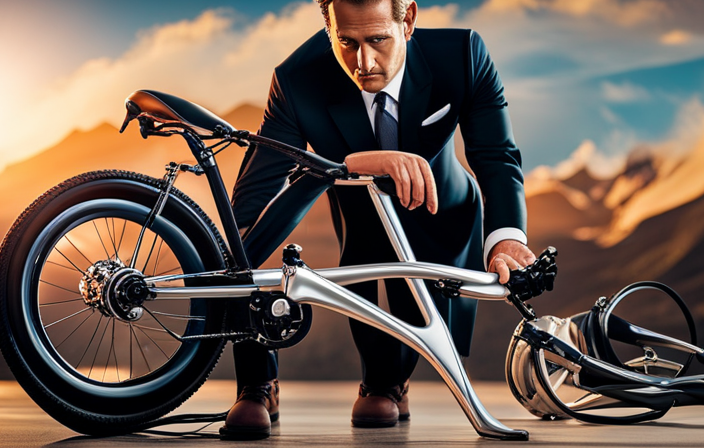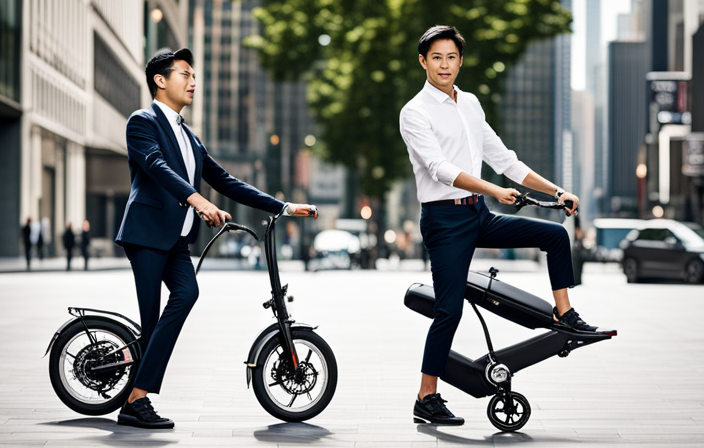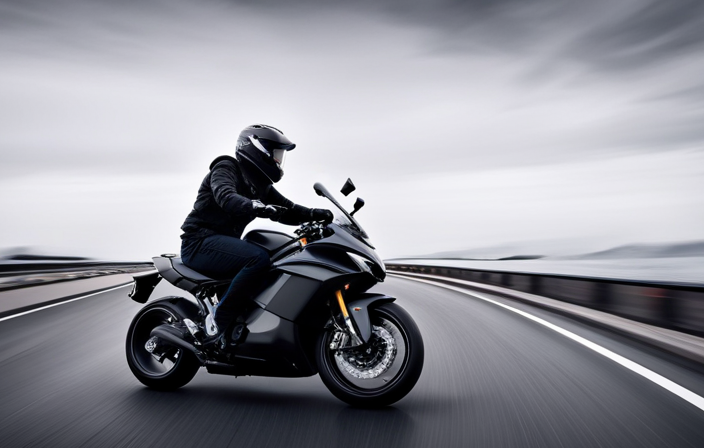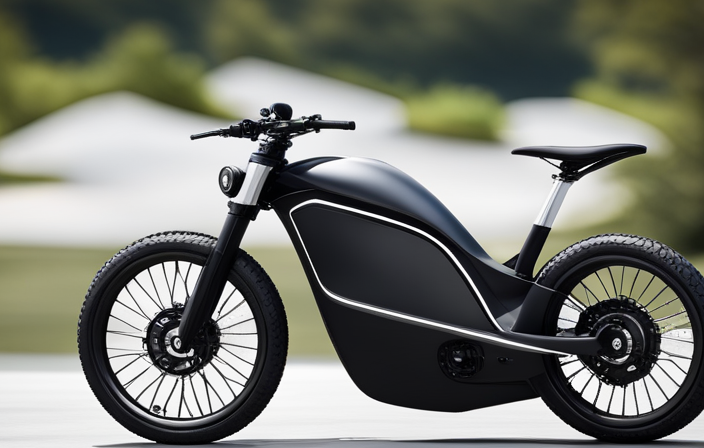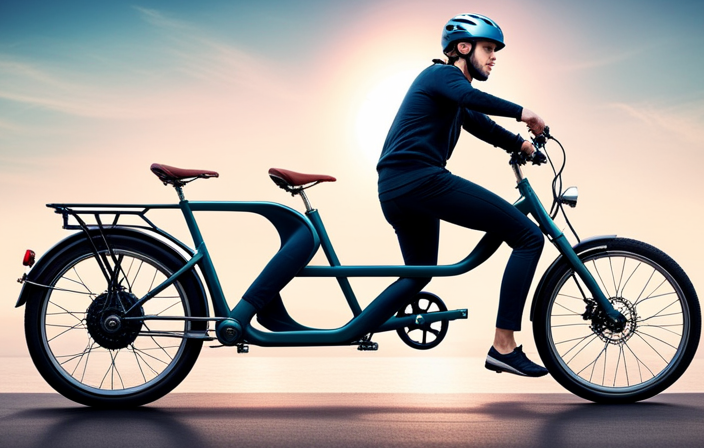Imagine the thrill of cruising down the street on a bike, effortlessly gliding past traffic and conquering hills with ease. Now, picture that bike equipped with an electric motor, giving you the power to go even faster and farther.
In this article, I will guide you through the process of converting your ordinary bike into an electric one. From understanding different conversion kits to ensuring safety and legal compliance, get ready to embark on an electrifying adventure on two wheels.
Key Takeaways
- There are different types of electric bike conversion kits, including front wheel hub motor, rear wheel hub motor, and mid-drive motor.
- Gathering the necessary tools and equipment, such as wrench set, pliers, screwdriver set, and multimeter, is important for the conversion process.
- Preparing the bike for conversion involves installing the battery, mounting it securely, and connecting the battery charger. It also requires understanding electric bike components like the motor, battery, controller, and sensor.
- Mounting the electric motor correctly is crucial for optimal performance. This includes choosing the right position, securing the motor to the bike frame, and connecting it to the wheel using a chain or belt drive system for smooth power transfer.
Understand the Different Types of Electric Bike Conversion Kits
There are different types of electric bike conversion kits available. These kits allow you to transform your regular bike into an electric one by adding an electric motor.
The first type of electric bike motor is the front wheel hub motor. This motor is mounted on the front wheel and provides power directly to the front wheel.
The second type is the rear wheel hub motor, which is mounted on the rear wheel and provides power to the rear wheel.
Lastly, there is the mid-drive motor, which is mounted near the bottom bracket and provides power directly to the pedals, allowing for a more natural riding experience.
The benefits of electric bike conversion kits include increased speed, improved range, and the ability to tackle hilly terrains with ease.
Now that we understand the different types of electric bike conversion kits, let’s move on to gathering the necessary tools and equipment.
Gather the Necessary Tools and Equipment
First, you’ll need to gather all the necessary tools and equipment for the task. Here is a list of items you will need:
- Wrench set: to remove and install various components on your bike.
- Pliers: for gripping and cutting wires.
- Screwdriver set: for removing and installing screws.
- Multimeter: to test electrical connections and troubleshoot any issues.
Once you have gathered these tools, it’s time to start the conversion process. Understanding the conversion process is crucial before you begin. Familiarize yourself with the different components of an electric bike conversion kit, such as the motor, battery, controller, and sensor. Make sure you have a clear understanding of how these components work together.
With the necessary tools and knowledge in hand, you are now ready to prepare your bike for the conversion.
Prepare Your Bike for the Conversion
To prepare your bicycle for the conversion, start by gathering all the necessary tools and equipment mentioned earlier. Once you have everything you need, it’s time to begin the bike modification process. One of the key steps is the battery installation. This is where you will mount the battery onto your bike frame securely. To make this process easier, refer to the table below for a list of tools and equipment you will need:
| Tools | Equipment |
|---|---|
| Allen wrench | Battery pack |
| Screwdriver | Battery mount |
| Pliers | Battery charger |
Using the Allen wrench, unscrew the bolts on the bike frame and attach the battery mount in the desired location. Then, carefully secure the battery pack onto the mount. Once the battery is securely in place, connect the battery charger to the pack. This will ensure your battery stays charged and ready to power your electric bike. With the battery installation complete, we can now move on to the next step of the process: mounting the electric motor.
Mount the Electric Motor
When mounting the electric motor on the bike, it’s crucial to choose the right position to ensure optimal performance.
I secured the motor to the bike frame using sturdy brackets and bolts to ensure it stays in place during rides.
Once the motor was securely attached, I connected it to the wheel using a chain or belt drive system for a smooth and efficient transfer of power.
Choose the Right Position
For the best results, you should consider the right position when putting electric on a bike. Proper posture is crucial for optimal performance and comfort.
When choosing the right position, you need to consider the handlebar position. It should be adjusted to align with your body’s natural posture, allowing for a relaxed grip and easy maneuverability. Additionally, the handlebar should be positioned at a height that promotes good posture and reduces strain on your back and shoulders.
When the handlebar is in the right position, you’ll have better control over the bike and be able to navigate various terrains with ease.
Now, let’s move on to the next step and learn how to secure the motor to the bike frame.
Secure the Motor to the Bike Frame
Securing the motor to the bike frame ensures stability and optimal performance. There are different mounting options available, but the most common ones include using brackets or clamps.
When choosing a mounting option, it is important to consider the type of motor and frame you have. Make sure to select a mounting method that is compatible with both.
To secure the motor, start by positioning it in the desired location on the frame. Use the brackets or clamps to firmly attach the motor to the frame, making sure it is aligned properly. Tighten all bolts and screws securely to ensure the motor stays in place during rides.
Once the motor is securely mounted, you can move on to the next step of connecting it to the wheel, allowing the electric power to be transferred efficiently.
Connect the Motor to the Wheel
To securely attach the motor to the bike frame, I followed the recommended steps and used sturdy mounting brackets.
Now that the motor is firmly in place, it’s time to connect it to the wheel. This step is crucial as it determines the power transfer and overall performance of the electric bike.
To ensure optimal positioning, I carefully aligned the motor with the wheel axle, making sure they are parallel to each other. Then, I used a torque arm to prevent the motor from rotating and shifting during operation.
Additionally, I double-checked the tightness of all the bolts and nuts to guarantee a secure connection. These motor installation tips helped me achieve a reliable and efficient electric bike setup.
Now, let’s move on to the next step: connecting the wiring for a fully functional electric bike system.
Connect the Wiring
First, make sure you have all the necessary tools and materials to connect the wiring on your bike. You will need wire cutters, wire strippers, electrical tape, and a soldering iron. To begin, identify the wires coming from the motor and the wires in your bike’s frame. Use wire cutters to trim the wires to the appropriate length and strip the insulation off the ends. Connect the wires together using wire connection techniques such as soldering or crimping. Once all the connections are made, use electrical tape to secure and insulate them. It is important to ensure that all the connections are properly made and there are no loose or exposed wires. Troubleshooting common wiring issues, such as shorts or faulty connections, may be necessary. Finally, test and adjust the electric assist to ensure it is working properly before moving on to the next step of your bike modification project.
Test and Adjust the Electric Assist
Next, it’s important to test and fine-tune the electric assist to ensure optimal performance.
To begin, test the efficiency of the electric system by taking the bike for a ride on different terrains and inclines. Observe how the motor responds and assess if it provides enough power to assist while pedaling.
If any issues arise, troubleshoot the problems by checking the wiring connections, battery voltage, and controller settings. Make necessary adjustments to enhance the electric assist’s efficiency.
Additionally, pay attention to any unusual noises, vibrations, or sudden power cuts, as these could indicate underlying problems.
Once satisfied with the performance, transition into the subsequent section about ensuring safety and legal compliance by conducting a thorough inspection of the bike’s overall condition and installing any required safety features.
Ensure Safety and Legal Compliance
Once you have tested and adjusted the electric assist, it is important to ensure the bike is safe and legally compliant. Promoting environmental sustainability, electric bikes are becoming more popular, but it is crucial to follow safety guidelines and regulations. Ensuring proper maintenance and upkeep is essential to keeping your electric bike running smoothly and safely. To achieve this, regular inspections should be conducted to check for any loose or worn parts, ensuring that brakes, lights, and other safety features are in working order. Additionally, it is important to familiarize yourself with local laws regarding electric bikes, such as speed limits and where they are allowed to be ridden. By adhering to these guidelines, you can enjoy the benefits of electric biking while also promoting safety and environmental consciousness. Moving forward, it is crucial to get familiar with riding an electric bike.
Get Familiar with Riding an Electric Bike
To become comfortable with operating an e-bike, it’s important to spend time practicing and getting to know how it handles. Start by choosing the right gear. A properly fitted helmet is essential for safety. Additionally, wear comfortable and weather-appropriate clothing.
Once you have your gear sorted, find a safe and open area to practice riding your electric bike. Begin by familiarizing yourself with the controls and how they work. Practice starting and stopping, turning, and going up and down hills. Gradually increase your speed and distance as you become more confident.
Pay attention to how the bike accelerates and brakes, and get a feel for the different power assist levels. Remember to always follow traffic laws and ride defensively.
By gaining experience and becoming confident on your electric bike, you can then enjoy the benefits it offers, such as increased speed and efficiency, without compromising safety.
Enjoy the Benefits of an Electric Bike
You can fully experience the advantages an e-bike offers by enjoying increased speed and efficiency while staying safe. One of the key benefits of an electric bike is the reduced maintenance compared to a traditional bike. With fewer moving parts, there is less wear and tear, making it easier and cheaper to maintain. However, it is important to choose the right battery for your electric bike to ensure optimal performance. Consider factors such as battery capacity, voltage, and weight. A higher capacity battery will provide a longer range, while a higher voltage battery will offer more power. Additionally, a lighter battery will make your bike easier to handle. Take the time to research and select the battery that best suits your needs. By properly maintaining your electric bike and choosing the right battery, you can enjoy all the benefits it has to offer. Now, let’s move on to sharing your experience and spreading the word about electric bikes.
Share Your Experience and Spread the Word
When it comes to sharing my experience with electric biking, I find that joining online communities and forums is a great way to connect with fellow enthusiasts and gain valuable insights.
Participating in electric bike events not only allows me to showcase my own electric bike, but also learn from others and stay up to date with the latest trends and technologies.
Lastly, I always make it a point to encourage others to try electric biking, as it not only promotes a greener mode of transportation but also offers a fun and efficient way to get around.
Join Online Communities and Forums
Joining online communities and forums is a great way to learn how to put electric on a bike. These online platforms provide a wealth of knowledge and expertise from people who have already gone through the process. By actively participating in these communities, you can ask questions, seek advice, and gain insights from experienced individuals.
Online communities allow you to share your own experiences and learn from others’ successes and challenges. Engaging in forum discussions enables you to stay updated with the latest advancements and trends in electric bike conversions. Additionally, you can find valuable resources such as step-by-step guides, video tutorials, and product recommendations.
By immersing yourself in these online communities, you can enhance your understanding of electric bike conversions and connect with like-minded individuals.
Transitioning into the subsequent section about ‘participate in electric bike events,’ you can expand your knowledge even further by attending workshops and demonstrations.
Participate in Electric Bike Events
After joining online communities and forums, I realized that there is a whole world out there dedicated to electric biking. This led me to explore another exciting way to learn more and get involved: participating in electric bike events.
These events bring together electric bike enthusiasts from all over, providing opportunities to learn from experienced riders, see the latest technology, and even compete in races. Not only are these events thrilling and fun, but they also serve as a platform to promote electric biking in schools and other educational institutions.
By showcasing the benefits and possibilities of electric biking to younger generations, we can encourage a greener and more sustainable mode of transportation. So, let’s dive into the world of electric bike events and inspire others to join the movement towards a cleaner future.
Encourage Others to Try Electric Biking
To get others involved in the electric biking movement, why not encourage your friends and family to give it a try? Sharing your experiences can be a powerful way to influence others and spread the benefits of electric biking.
Start by explaining the advantages, such as increased mobility, reduced carbon emissions, and improved fitness. Share stories of how electric biking has positively impacted your life, whether it’s commuting to work or exploring new trails.
Highlight the convenience and ease of use, emphasizing that electric bikes are suitable for all fitness levels and ages. Offer to accompany them on their first electric bike ride to help them feel comfortable and confident.
By encouraging others and sharing your experiences, you can inspire a whole new wave of electric bike enthusiasts.
Frequently Asked Questions
How much does an electric bike conversion kit cost?
The cost of an electric bike conversion kit can vary depending on the brand, quality, and features. It is important to do a cost comparison and research the best conversion kits available in order to make an informed decision.
Can any type of bike be converted into an electric bike?
Yes, any type of bike can be converted into an electric bike. Electric bike conversion kits are designed to be compatible with different bike models, allowing you to enjoy the benefits of an electric bike without having to purchase a new one.
How long does it take to complete the conversion process?
The conversion process duration for adding electric components to a bike varies depending on experience and tools available. Typically, it takes a few hours to a few days. Necessary tools include wrenches, screwdrivers, and a conversion kit with a motor, battery, and controller.
Are there any specific safety precautions to keep in mind when riding an electric bike?
When riding an electric bike, it is crucial to prioritize safety. Always wear proper safety gear such as a helmet, knee pads, and reflective clothing. Additionally, regular maintenance is essential for optimal performance and safety.
Are there any legal restrictions or regulations regarding the use of electric bikes on public roads?
Legal requirements for electric bikes vary by jurisdiction, but generally include age restrictions, speed limits, and the need for a valid driver’s license. Despite these regulations, the benefits of electric bikes, such as eco-friendliness and cost-effectiveness, make them a popular choice for commuting.
Conclusion
In conclusion, the process of putting electric on a bike is an exhilarating journey that combines the thrill of riding with the convenience of technology.
By understanding the different types of conversion kits and gathering the necessary tools, you can transform your regular bike into an electrifying machine.
With careful preparation and installation, you’ll be zipping through streets with ease.
However, it’s important to remember safety and legal compliance to ensure a smooth and worry-free ride.
So, hop on your newly electrified bike, feel the power, and spread the word about this incredible experience!
